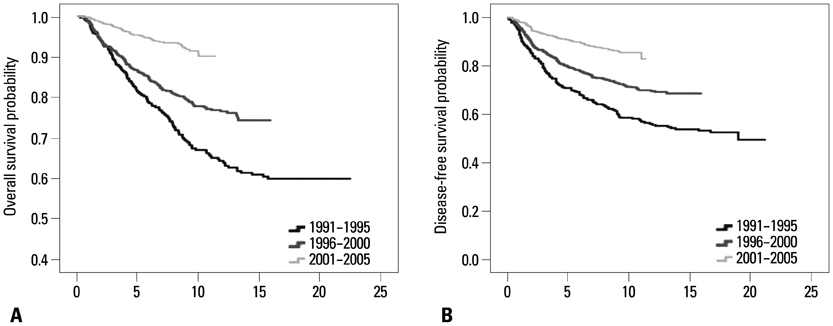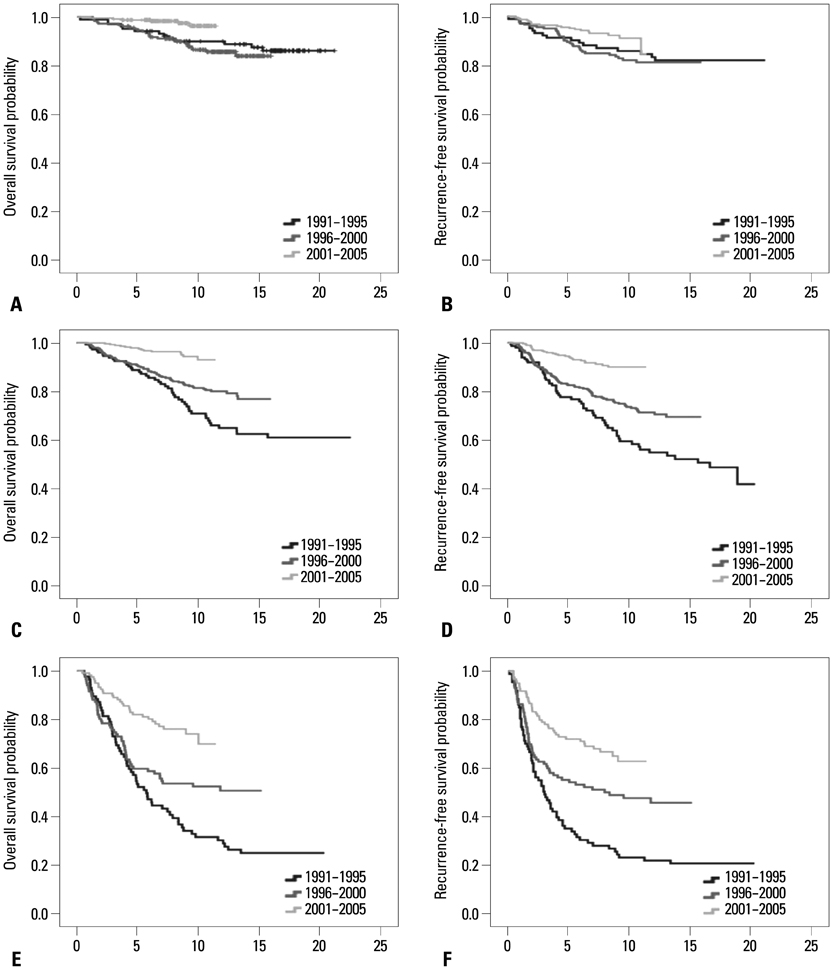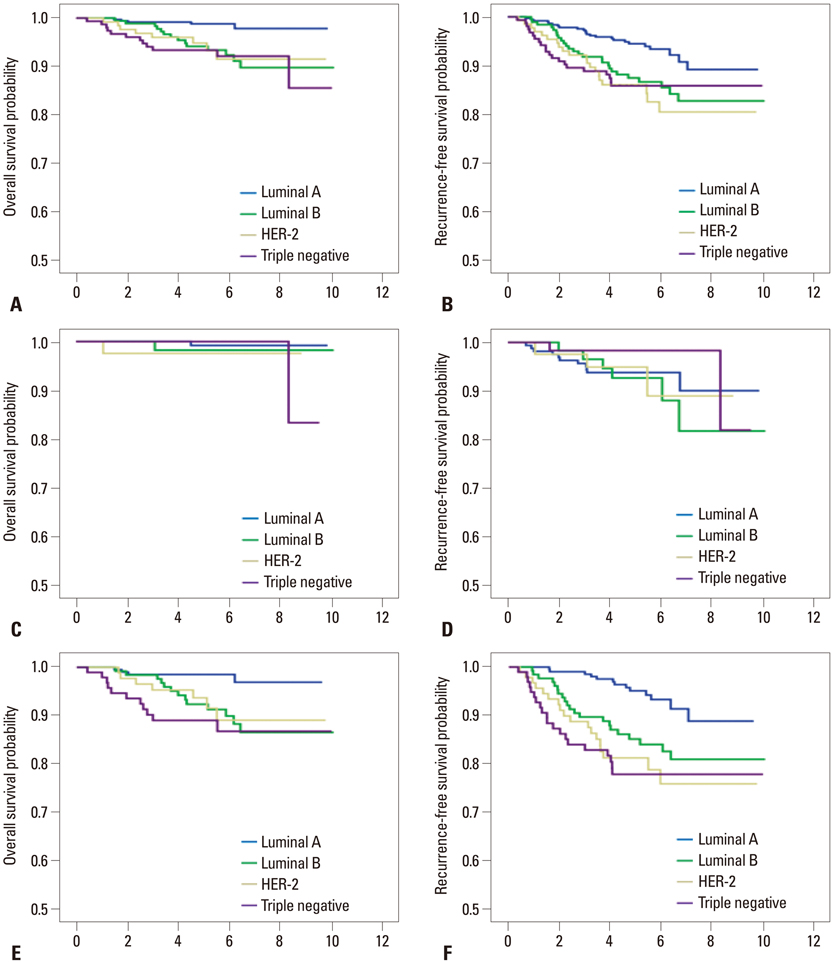Yonsei Med J.
2014 Sep;55(5):1187-1195. 10.3349/ymj.2014.55.5.1187.
Long-Term Survival Analysis of Korean Breast Cancer Patients at a Single Center: Improving Outcome Over Time
- Affiliations
-
- 1Department of Surgery, Gangnam Severance Hospital, Yonsei University College of Medicine, Seoul, Korea. gsjjoon@yuhs.ac
- 2Department of Surgery, Eulji General Hospital, Eulji University College of Medicine, Seoul, Korea.
- KMID: 1799480
- DOI: http://doi.org/10.3349/ymj.2014.55.5.1187
Abstract
- PURPOSE
The prognosis of breast cancer has been consistently improving. We analyzed our cohort of breast cancer patients with a long-term follow up at a single center over time.
MATERIALS AND METHODS
A total of 1889 patients with known cancer stages were recruited and analyzed between January 1991 and December 2005. Patients were classified according to the time periods (1991-1995; 1996-2000; 2001-2005). To determine intrinsic subtypes, 858 patients whose human epidermal growth receptor-2 status and Ki67 were reported between April 2004 and December 2008 were also analyzed.
RESULTS
At a median follow up of 9.1 years, the 10-year overall survival (OS) rate was 80.5% for the entire cohort. On multivariate analysis for OS and recurrence-free survival (RFS), the time period was demonstrated to be a significant factor independent of conventional prognostic markers. In the survival analysis performed for each stage (I to III), OS and RFS significantly improved according to the time periods. Adoption of new agents in adjuvant chemotherapy and endocrine therapy was increased according to the elapsed time. In the patients with known subtypes, OS and RFS significantly differed among the subtypes, and the triple-negative subtype showed the worst outcome in stages II and III.
CONCLUSION
In the Korean breast cancer cohort with a long-term follow up, our data show an improved prognosis over the past decades, and harbor the contribution of advances in adjuvant treatment. Moreover, we provided new insight regarding comparison of the prognostic impact between the tumor burden and subtypes.
Keyword
MeSH Terms
Figure
Cited by 1 articles
-
Comparisons of Oncologic Outcomes between Triple-Negative Breast Cancer (TNBC) and Non-TNBC among Patients Treated with Breast-Conserving Therapy
Sanghwa Kim, Hyung Seok Park, Jee Ye Kim, Jegyu Ryu, Seho Park, Seung Il Kim
Yonsei Med J. 2016;57(5):1192-1198. doi: 10.3349/ymj.2016.57.5.1192.
Reference
-
1. Parkin DM, Bray F, Ferlay J, Pisani P. Global cancer statistics, 2002. CA Cancer J Clin. 2005; 55:74–108.
Article2. Jung KW, Park S, Kong HJ, Won YJ, Boo YK, Shin HR, et al. Cancer statistics in Korea: incidence, mortality and survival in 2006-2007. J Korean Med Sci. 2010; 25:1113–1121.
Article3. Lee JH, Yim SH, Won YJ, Jung KW, Son BH, Lee HD, et al. Population-based breast cancer statistics in Korea during 1993-2002: incidence, mortality, and survival. J Korean Med Sci. 2007; 22:Suppl. S11–S16.
Article4. The Korean Breast Cancer Society. Nationwide Korean Breast Cancer Data of 2004 Using Breast Cancer Registration Program. J Breast Cancer. 2006; 9:151–161.5. Son BH, Kwak BS, Kim JK, Kim HJ, Hong SJ, Lee JS, et al. Changing patterns in the clinical characteristics of Korean patients with breast cancer during the last 15 years. Arch Surg. 2006; 141:155–160.
Article6. Jung KW, Won YJ, Kong HJ, Oh CM, Seo HG, Lee JS. Cancer statistics in Korea: incidence, mortality, survival and prevalence in 2010. Cancer Res Treat. 2013; 45:1–14.
Article7. Dawood S, Broglio K, Gonzalez-Angulo AM, Buzdar AU, Hortobagyi GN, Giordano SH. Trends in survival over the past two decades among white and black patients with newly diagnosed stage IV breast cancer. J Clin Oncol. 2008; 26:4891–4898.
Article8. Early Breast Cancer Trialists' Collaborative Group (EBCTCG). Effects of chemotherapy and hormonal therapy for early breast cancer on recurrence and 15-year survival: an overview of the randomised trials. Lancet. 2005; 365:1687–1717.9. Trudeau M, Charbonneau F, Gelmon K, Laing K, Latreille J, Mackey J, et al. Selection of adjuvant chemotherapy for treatment of node-positive breast cancer. Lancet Oncol. 2005; 6:886–898.
Article10. Piccart-Gebhart MJ, Procter M, Leyland-Jones B, Goldhirsch A, Untch M, Smith I, et al. Trastuzumab after adjuvant chemotherapy in HER2-positive breast cancer. N Engl J Med. 2005; 353:1659–1672.11. Romond EH, Perez EA, Bryant J, Suman VJ, Geyer CE Jr, Davidson NE, et al. Trastuzumab plus adjuvant chemotherapy for operable HER2-positive breast cancer. N Engl J Med. 2005; 353:1673–1684.
Article12. Cancer Genome Atlas Network. Comprehensive molecular portraits of human breast tumours. Nature. 2012; 490:61–70.13. Perou CM, Sørlie T, Eisen MB, van de Rijn M, Jeffrey SS, Rees CA, et al. Molecular portraits of human breast tumours. Nature. 2000; 406:747–752.
Article14. Singletary SE, Allred C, Ashley P, Bassett LW, Berry D, Bland KI, et al. Staging system for breast cancer: revisions for the 6th edition of the AJCC Cancer Staging Manual. Surg Clin North Am. 2003; 83:803–819.
Article15. Hammond ME, Hayes DF, Dowsett M, Allred DC, Hagerty KL, Badve S, et al. American Society of Clinical Oncology/College of American Pathologists guideline recommendations for immunohistochemical testing of estrogen and progesterone receptors in breast cancer (unabridged version). Arch Pathol Lab Med. 2010; 134:e48–e72.16. Goldhirsch A, Wood WC, Coates AS, Gelber RD, Thürlimann B, Senn HJ, et al. Strategies for subtypes-dealing with the diversity of breast cancer: highlights of the St. Gallen International Expert Consensus on the Primary Therapy of Early Breast Cancer 2011. Ann Oncol. 2011; 22:1736–1747.
Article17. Carey LA, Perou CM, Livasy CA, Dressler LG, Cowan D, Conway K, et al. Race, breast cancer subtypes, and survival in the Carolina Breast Cancer Study. JAMA. 2006; 295:2492–2502.
Article18. Lee JA, Kim KI, Bae JW, Jung YH, An H, Lee ES, et al. Triple negative breast cancer in Korea-distinct biology with different impact of prognostic factors on survival. Breast Cancer Res Treat. 2010; 123:177–187.
Article19. O'Brien KM, Cole SR, Tse CK, Perou CM, Carey LA, Foulkes WD, et al. Intrinsic breast tumor subtypes, race, and long-term survival in the Carolina Breast Cancer Study. Clin Cancer Res. 2010; 16:6100–6110.20. Park YH, Lee SJ, Cho EY, Choi YL, Lee JE, Nam SJ, et al. Clinical relevance of TNM staging system according to breast cancer subtypes. Ann Oncol. 2011; 22:1554–1560.
Article21. Sanpaolo P, Barbieri V, Genovesi D. Prognostic value of breast cancer subtypes on breast cancer specific survival, distant metastases and local relapse rates in conservatively managed early stage breast cancer: a retrospective clinical study. Eur J Surg Oncol. 2011; 37:876–882.
Article22. Theriault RL, Litton JK, Mittendorf EA, Chen H, Meric-Bernstam F, Chavez-Macgregor M, et al. Age and survival estimates in patients who have node-negative T1ab breast cancer by breast cancer subtype. Clin Breast Cancer. 2011; 11:325–331.
Article
- Full Text Links
- Actions
-
Cited
- CITED
-
- Close
- Share
- Similar articles
-
- A Case of Five-Year Survival in Metastatic Pancreatic Cancer
- Charlson Comorbidity Index as a Predictor of Long-Term Survival after Surgery for Breast Cancer: A Nationwide Retrospective Cohort Study in South Korea
- Long-term follow-up study and long-term care of childhood cancer survivors
- Expression of bcl-2 and Apoptosis and Its Relationship to Clinicopathological Prognostic Factors in Breast Cancer - A Study with Long Term Follow-up
- Clinical Analysis of 28 Multiple Primary Cancers (MPC) Including Breast Cancer




